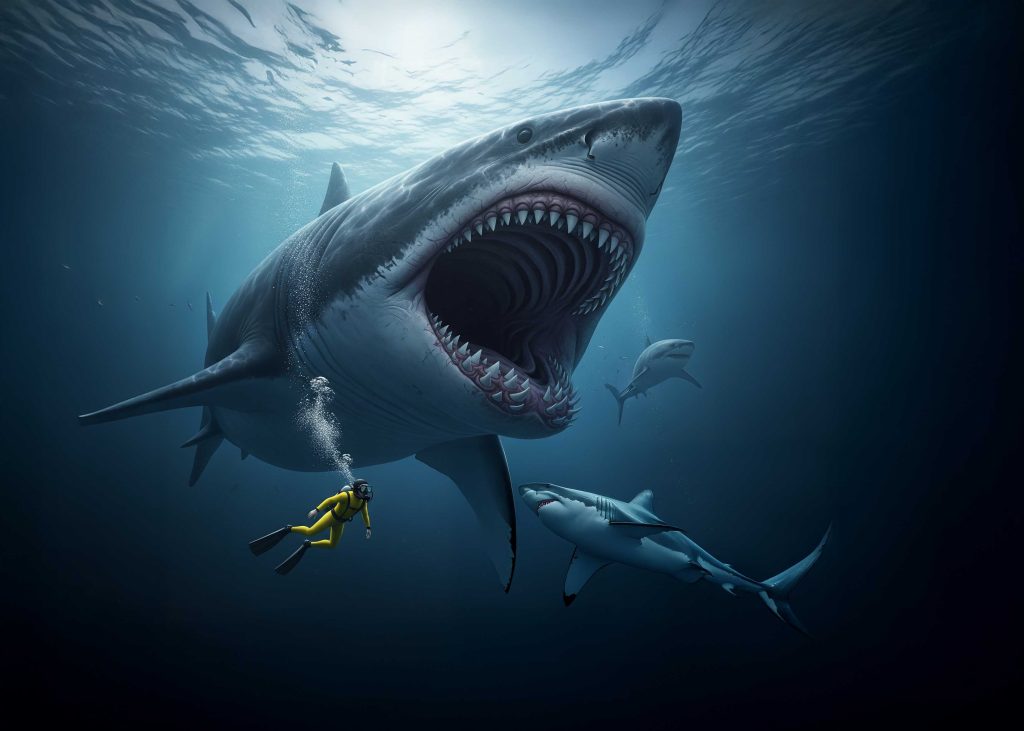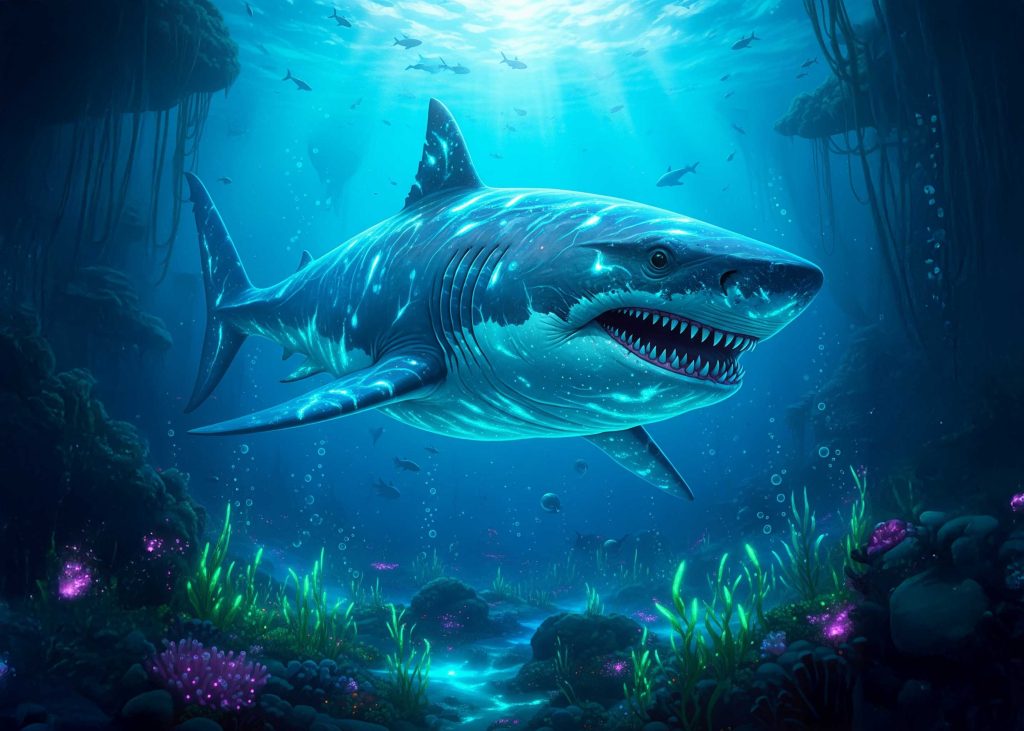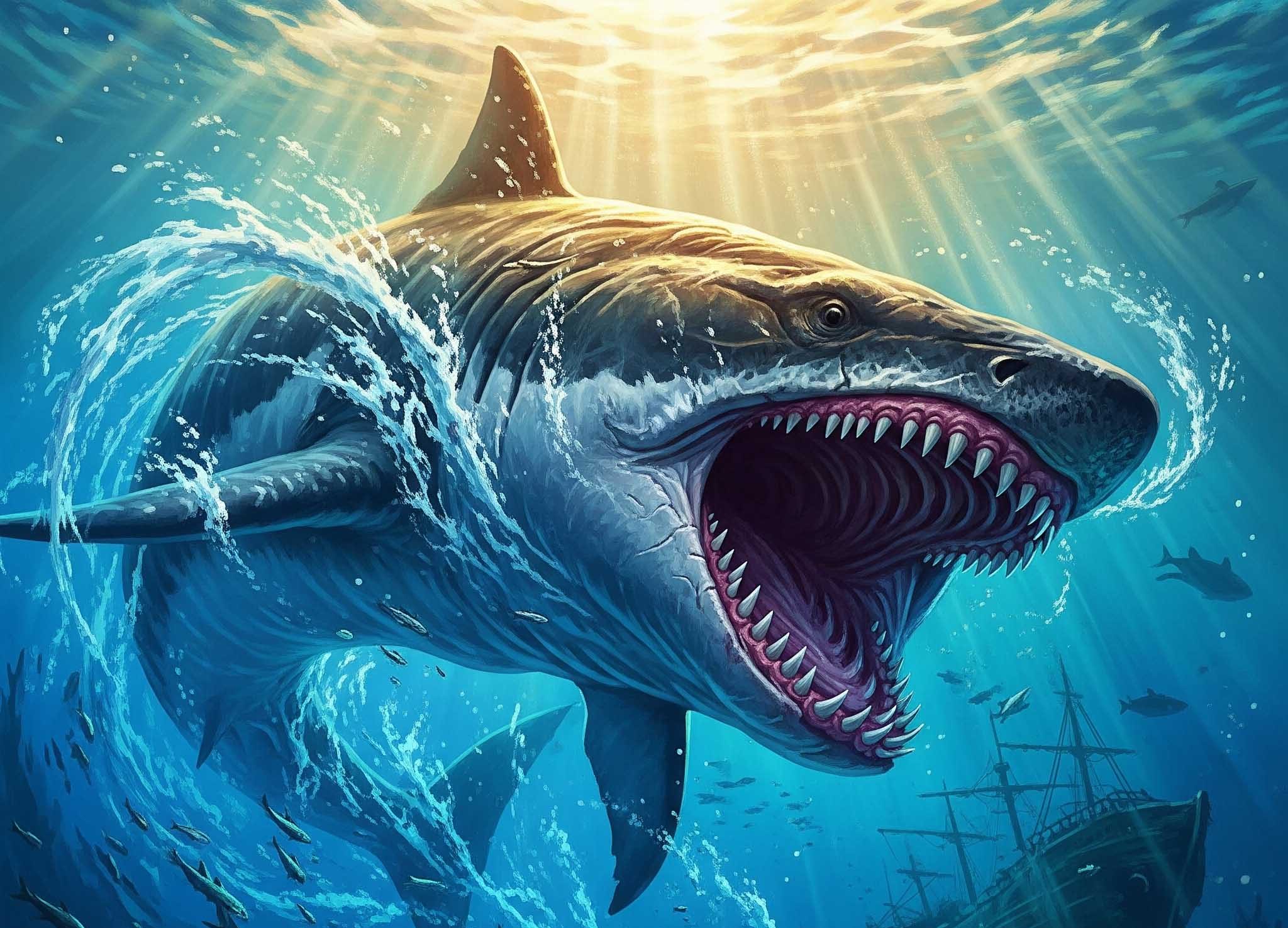Imagine swimming in the ocean, and suddenly, a shadow falls over you. Not just any shadow, but one so big it blocks out the sun! Then, you see a giant mouth, big enough to swallow a car, filled with teeth the size of your hand. That’s what it might have felt like to meet Megalodon.
For more than 20 million years, the oceans were ruled by this incredible creature: Otodus megalodon. This wasn’t just a shark; it was the largest and most powerful marine predator in the history of the planet. It could grow up to 18 meters (60 feet) long—that’s three times the length of a great white shark, or about as long as a bowling alley!
If Megalodon was so powerful, so big, and ruled the oceans for so long, where did it go? Why isn’t it still swimming in our seas today? That’s a mystery scientists have been trying to solve.
Don’t Miss This!
After reading, challenge yourself with our interactive quiz at the end. Click here to take the Quiz
Index

A depiction of Megalodon, showing its immense size compared to a human and a great white shark.
A Global Hunter with a Bone-Crushing Bite
Megalodon lived from about 23 to 3.6 million years ago. Its fossils have been found all over the world, from the warm waters near the equator to the cooler waters near the poles. This tells us it was a global hunter, able to live in many different places.
Its favorite food? The biggest animals in the sea! Megalodon loved to hunt whales, dolphins, and giant sea turtles. Imagine a shark that could eat a whale for dinner! Its teeth are the most common fossils we find of Megalodon. They were huge, up to 18 centimeters (7 inches) long, and had jagged edges, like a steak knife. These teeth were perfect for tearing through the flesh and bones of its giant prey.
Scientists have studied the bite marks left by Megalodon on ancient whale bones. They estimate its bite force was the most powerful of any known animal, ever! It could bite with a force of between 110,000 and 180,000 newtons. To give you an idea, that’s strong enough to crush a whale’s skull as easily as you might crush a grape. For millions of years, Megalodon was at the undisputed top of the food chain, the king of the ocean.
“Its bite force was the most powerful of any known animal, estimated to be between 110,000 and 180,000 newtons—strong enough to crush a whale’s skull as easily as a human can crush a grape.”
Theories of Extinction
The disappearance of Megalodon around 3.6 million years ago has been a long-standing scientific mystery. There wasn’t a single, sudden disaster like an asteroid impact that wiped it out. Instead, scientists believe a combination of things slowly pushed this super-predator to the brink, and then, over the edge.
Here are the main ideas about why Megalodon disappeared:
- Climate Change and Sea Level Drops: The Earth started to get colder around 3.6 million years ago. This was the beginning of the Ice Ages. As the planet cooled, huge amounts of water got locked up in giant ice sheets at the North and South Poles. This caused sea levels to drop dramatically.
- Loss of Nurseries: Megalodon, like many sharks, probably used shallow, warm-water areas near the coast as nurseries to have and raise its babies. When sea levels dropped, these important nursery habitats disappeared. Without safe places for baby Megalodons to grow up, fewer of them survived to become adults.
- Disappearance of Prey: The changing climate also affected Megalodon’s favorite food. Many species of large whales that the adult sharks loved to eat either went extinct because of the colder waters or moved to the very cold polar waters where Megalodon couldn’t follow. Imagine your favorite restaurant closing down and all the other restaurants only serving food you don’t like!
- Competition from a New Predator: As Megalodon’s world was changing, a new, smaller, but perhaps smarter, predator was on the rise: the great white shark (Carcharodon carcharias). While a great white would be no match for a full-grown Megalodon, they may have competed for the same food sources, especially smaller whales and seals. The great white shark was more adaptable; it could live in a wider range of water temperatures and was a very clever hunter. This gave it a crucial edge in a changing world.
What We’re Still Learning About Megalodon
Scientists are always finding new clues about Megalodon. For example, it’s hard to know exactly how big Megalodon was because most of what we find are its teeth. But recently, scientists have been using computer models and comparing Megalodon teeth to modern shark teeth to get a better idea of its full body size and shape. Some new research suggests it might have been even more slender than we thought, making it a faster swimmer!
Another exciting area of study is looking at the growth rings in Megalodon teeth. Just like trees have rings that tell us their age, shark teeth have growth rings. By studying these, scientists can learn about how fast Megalodon grew, how long it lived, and even when it had its babies. This helps us understand its life story better.
There’s also ongoing debate about whether Megalodon was truly warm-blooded, like some modern sharks. If it was, that would have helped it hunt in colder waters, but it would also mean it needed even more food to keep its body warm. These new ideas keep the mystery of Megalodon alive and exciting!
“The story of Megalodon’s extinction is a powerful reminder that even the most dominant predators are vulnerable to environmental change.”
Tale from the Deep Past
The story of Megalodon’s extinction is a powerful reminder that even the most dominant predators are vulnerable to environmental change. Its reign was not ended by a bigger, badder monster, but by a changing world that it could not adapt to.
The vanishing of the ocean’s greatest hunter shows that size and strength are no guarantee of survival when the ecosystem that supports you begins to crumble. It’s a lesson that even today, in our own changing world, is very important to remember.

Megalodon Quiz
How much do you know about the largest shark that ever lived?


Leave a Reply to Megalodon Habitat and Diet – Eoniverse Cancel reply